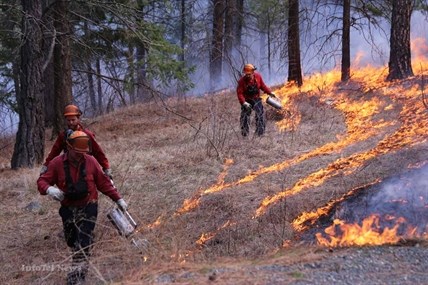
Crews work in tandem to start the controlled burn at the Skihist Provincial Park campgrounds this week.
(JENNIFER STAHN / iNFOnews.ca)
April 07, 2014 - 11:15 AM
THOMPSON-OKANAGAN — Understanding fire, how it will travel, what it will travel through and what the ambient conditions will do to it is not only a science, it's an art form.
It's also something the guys and gals at B.C. Wildfire take great pride in and it was obvious watching them work at a controlled burn this week. In a controlled setting crews ensure the fire goes only where they want it to by using fire guards and other precautions not always available to them during a wildfire.
Fire Information Officer Kayla Pepper says they prefer to burn at this time of year because of the weather.
“It's ideal,” she says, “The temperature still drops overnight and there's little chance of flame action.”
Prescribed burns are used as a way to rehabilitate ecosystems by allowing fire to rip through an area in a controlled manner. They allow native grasses and plants, and ultimately wildlife, to return to the area by getting rid of invasive species. It also helps to open up seeds that need the heat of fire to start the growing process.
These burns are also used as a way to keep people safer. Wildfires are not allowed to get too close to homes and because of the number of neighbourhoods pocketed throughout the region natural fires are often extinguished before they can do what they need to. Fire is a part of the natural cycle and without it grasses and brush can overgrow and present a higher risk if a wildfire does hit.
Initial Attack Leader Ryan Sharp was also the Incident Commander for the 34 hectare controlled burn just northwest of Lytton Wednesday. He notes safety is a big part of the reason why they tend to not let natural fires burn in B.C.
“These days we don't just let fires happen... we have to put them out because there (are) communities at risk,” he says, adding controlled burns help to mitigate future risk. “But it would happen naturally if it wasn't for us putting them out and so this way we get to let what happens naturally to occur in a controlled manner. It has the added benefit of being good fire management practices for this area, generally if it burns now, it won't burn again to the same extent in the near future.”
Torches are used to ignite dried grasses and brush and several crew members will work in an area at a time, adding lines of fire that will eventually grow into one larger fire. Towers and signs posts are wet down to ensure the fire doesn't touch them. The act is so precise even controlled burns in campgrounds can be conducted without damaging the posts and tables.
Because the intensity of a controlled burn tends to be a bit lower, grasses and flowers will often bounce back by the following year, more lush and vibrant than they have been in years.
Pepper says one field she saw a year after a controlled burn was the most beautiful she has ever seen while the trees up near Barriere are still bare because of the intensity of the wildfire that ripped through the area 10 years ago.
Controlled burns will continue to take place throughout the region over the next several weeks, including a large one south of Lytton, several smaller ones in both the North and South Okanagan.
To contact a reporter for this story, email Jennifer Stahn at jstahn@infotelnews.ca or call 250-819-3723. To contact an editor, email mjones@infotelnews.ca or call 250-718-2724.
News from © iNFOnews, 2014